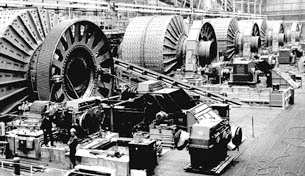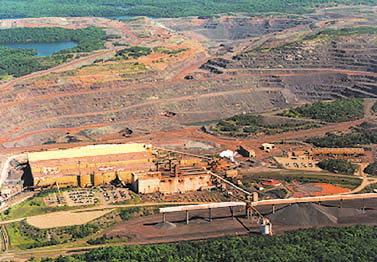U.P.'s Tilden, Empire mines carve out niche in state history
Date Posted: May 25 2001
Michigan has a heavy metal heritage.
The stamping, axle and assembly plants in Southeast Michigan and the rest of the Great Lakes region get all the notoriety for the finished automotive and other products they produce, but the raw materials have to come from somewhere.
And a major part of that "somewhere" are the Tilden and Empire mines, located a few miles apart near Marquette in the Upper Peninsula. The mines are owned by Cliffs Mining Service Co., a subsidiary of Cleveland-Cliffs Inc. Together, the open pit operations produce about 20 percent of North America's iron ore, and provide jobs to more than 1,800 hundred people.
Over the years the mines have also provided tens of thousands of man-hours for the building trades in new construction, renovation, and regular on-site work.
"There's no question that along with the paper mills, the mines in the U.P. have been a major source of work for the building trades, even back before World War II," said Jack LaSalle, the U.P. business rep. for the Michigan Building and Construction Trades Council. "Over the last 50 years, I would estimate that mining has generated as much as 50 percent of all construction work in the U.P. The mining industry is that significant."
The everyday workforce inside the mines are primarily United Steel Workers union members, but the building trades are brought in during periodic renovations and expansions. LaSalle said the mines "have been excellent" when it comes to employing union building trades.
"The building trades have been an important part of our history," said Don Ryan, district manager, public affairs for the Cliffs Mining Service Co. "Some of the operations and equipment at the mines are just huge, and it was the highly skilled people in the building trades crafts who made it all work."
Taking iron ore out of the ground has been part of the heritage of the Upper Peninsula since 1844. That year, iron ore was discovered by a state survey crew near Teal Lake, just west of Marquette. Surveyors noted wild fluctuations in their compasses because of iron-rich rocks found in the ground. Mining began there in 1847 at the Jackson Mine.
High-grade ore was mined in the Marquette Range until the 1950s, when it was finally depleted. The hematite and magnetite ore being mined today was once considered worthless rock, because there was no practical method to unlock the iron-bearing material. As it is, about a half-ton of rock must be removed to gain access to every ton of hematite ore, and about a ton of rock must be removed to gain access to every ton of magnetite ore.
The ore that is hauled from the pit is 35% iron and the finished pellets are about 65% iron.
The fortunes and economics of mining have been up and down over the years, with mines opening and closing. One of the major milestones for mining at the Tilden location took place 1972, when the mine's owners committed to spend $200 million over nearly a three-year period to develop the Tilden mine and install a pelletizing complex.
At the Empire Mine, which opened in 1963, production capacity in the early 1970s was nearly tripled with an expenditure of $67 million in new equipment. In order to power the plants, $55 million was spent to increase the output of the Presque Isle Generating Co. with three additional 80 megawatt generators. At the peak of construction activity in 1973, up to 1,400 construction workers were on the project.
Then in 1979, the production capacity of both mines was nearly doubled. A $364 million expansion of the Tilden Mine and additional expenditures at the Empire Mine allowed the mines the ability to produce iron ore pellets at full capacity - 16 million tons a year - which is the capacity today.
The Empire Mine's iron ore pellets go through Escanaba's docks, usually to steel mill blast furnaces in the Chicago area; the Tilden Mine's output usually goes through the Marquette dock to the Algoma Steel Plant in Sault Ste. Marie, Ontario.
The mines run 24 hours, seven days a week. When capacity needs to be cut, they often shut down for a period of weeks, rather than operating below capacity. In fact, a large inventory of iron ore has already shut down the Tilden Mine for at least six weeks, and the Empire is slated to close for the same period of time on June 3.
Operating Engineers Local 324 members will take a big hit with the shutdown of the mines. Local 324 Business Rep. Bill Gray said the mines are among the U.P.'s biggest employers for the operators, whose efforts have mostly gone into building massive holding pond dikes.
"We run 30 to 40 operators at the mines during the season, and the shutdowns are probably going to cost us about 40,000 man-hours," Gray said. "The mines are very important to us and the shutdowns are going to hurt."
In time, the cost of transporting the ore from the ever-deepening pit bottoms - rather than the lack of quality ore reserves - will close the mines. Economically, it is the cost of transporting the materials out of the pit that will eventually trim the profit margin to zero. As it is, the bottom of the Empire Mine will soon become the lowest point in the state.

PRIMARY GRINDING LINES inside the Tilden Mine are showed during installation in 1974.

The Tilden Mine near Marquette in an aerial view.
